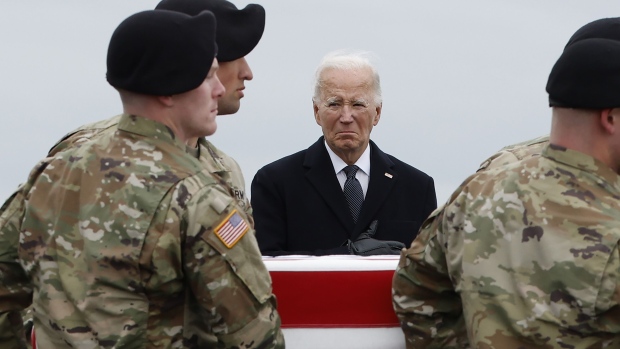Feb 2, 2024
Biden Delivers Reprisal to Iran With Room for De-Escalation
, Bloomberg News

(Bloomberg) -- US strikes on Iran’s militias and proxy forces fulfilled President Joe Biden’s promise to retaliate for the deaths of three US soldiers yet left room for both sides to back away from a high-risk confrontation.
The strikes fit with a plan Biden had telegraphed for days: He would inflict pain on Iran for the drone attack on a US base in Jordan by one of the Iraq-based militias it supports. He would demonstrate the full range of American power. And he would also keep his options open.
It was a strategy that underscored Biden’s desire to respond forcefully — and make Iran and its proxies think twice about future attacks — while also trying not to get the US pulled deeper into a regional conflict than it already has been.
“Our response began today,” Biden said in a statement. “It will continue at times and places of our choosing.”
Lurking in the background is his desire to keep the US-Iran confrontation from scuttling tentative negotiations between Israel and Hamas. Israel’s devastating response to the group’s surprise assault on Oct. 7, and US support for the Israeli government, is one reason Iran’s proxies cite for their repeated attacks.
“By demonstrating our overwhelming military power, perhaps we can turn the tables back to diplomacy in the Middle East,” said Evelyn Farkas, executive director of the McCain Institute who served at the Pentagon during the Obama administration. “Hopefully, it will give us the strength and the determination to pressure the Israeli government to go to the negotiating table, and also signal to Hamas that it is time to do so as well.”
Aircraft including long-range B-1 bombers flown from the US struck the 85 targets at seven sites linked to the Islamic Revolutionary Guards Corps’ Quds Force and to militant groups Iran funds, according to US officials. Targets included command-and-control facilities and supply depots for rockets, missiles and drones, US Central Command said.
Earlier: Three US Troops Killed in Attack Tied to Iran-Backed Groups
It was the most significant attack on the Quds force since 2020, when President Donald Trump ordered the assassination of General Qassem Soleimani in a drone strike outside Baghdad.
But the Soleimani killing didn’t deter Iran, and neither have successive US strikes on Iranian proxies in recent weeks. Beyond Iraq and Syria, the US is engaged in tit-for-tat strikes with another Iranian proxy, the Houthis in Yemen, whose missile attacks on commercial vessels in the Red Sea have disrupted global trade.
The biggest question from Friday night’s airstrikes was what the next step would be. On a call with reporters, a spokesman said there would be more in coming days.
“The key question I have and we all should have is — if we have in doing this also signaled to Iran that the next time Americans suffer casualties, we will strike targets in Iran,” James Jeffrey, former President Donald Trump’s top Syria adviser, told Bloomberg Television. “That’s the only thing that really deters Iran. Time will tell whether this has been enough.”
Biden’s team is aware of the stakes. Earlier this week, Secretary of State Antony Blinken said now was the most volatile time in the Middle East since at least 1973, the year of the Yom Kippur War when Egypt and Syria attacked Israel.
Hours before the strikes, Blinken announced he’d return to the region to make progress on the negotiations for a cease-fire and hostage deal between Israel and Hamas. Success could ease tensions and take away the impetus for Iranian proxies in Yemen and Lebanon — not to mention Hamas itself — to attack Israel and the US.
A Shifting Tone on Palestinian Statehood: Balance of Power
Biden’s Republican critics argued that the attacks were too little too late given the four-day delay from the day the US soldiers were killed, which some speculated gave Iranian officers a chance to flee.
“These strikes, announced well in advance, likely did not accomplish nearly enough to stop Iran’s axis,” Republican Senator Deb Fischer of Nebraska, a member of the Armed Services Committee, said in a statement.
The one thing that hasn’t occurred — and which Biden has no appetite for — is any sort of direct outreach or diplomacy with Iran. On the call with reporters, National Security Council spokesman John Kirby said the US had not had any communication with Iran since the three soldiers were killed on Jan. 28.
The Biden administration had been engaged in indirect talks with Iran to restore some elements of a nuclear non-proliferation deal Trump abandoned in 2018, and had seen tentative progress, including the release of several imprisoned Americans.
Those conversations came to a halt after Hamas’s Oct. 7 attack, and there has been little substantive communication since. Iran, in the meantime, has continued to enrich its uranium to 60 percent purity — though outside inspectors said it’s now doing so more slowly.
“A dangerous escalatory cycle has taken root,” said Suzanne DiMaggio, a senior fellow at the Carnegie Endowment for International Peace. “The notion that these tit-for-tat moves can be managed and kept from spiraling is a high-risk fantasy. A diplomatic settlement is sorely needed.”
--With assistance from Josh Wingrove, Jennifer Jacobs and Jordan Fabian.
©2024 Bloomberg L.P.








